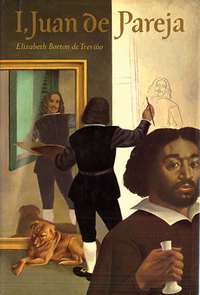I, Juan de Pareja
 | |
| Author | Elizabeth Borton de Treviño |
|---|---|
| Country | United States |
| Language | English |
| Genre | Children's novel |
| Publisher | Farrar Straus Giroux |
Publication date | June 1965 |
| Media type | Print (Hardback & Paperback) |
| Pages | 192 pp |
I, Juan de Pareja is a novel by Elizabeth Borton de Treviño that won the Newbery Medal for excellence in American children's literature in 1966.
The novel is written in the first person as by the title character, Juan de Pareja, a half-African slave of the artist Diego Velázquez, and model for one of Velázquez's most noted paintings, who earns his freedom through his own merits, artistic and otherwise.
Plot
Juan is born into slavery in Seville, Spain in the early 1600s, and after the death of his mother when he is just five years old he becomes the pageboy of a wealthy Spanish lady, Emilia.
Diego has a wife, Juana de Miranda, and two little girls, Paquita and Ignacia. Juan's main job is to help his master with his work of painting, preparing the colors, washing the brushes, stretching canvas', etc. However, Juan learns to paint as well, but since slaves in Spain are not allowed to practice any of the arts, his master cannot teach him how.
Soon, two apprentices, Cristobal and Alvaro, join the household to learn from Diego. Juan, whose opinions do not differ from his master and his family's, dislikes Cristobal, but finds Alvaro pleasant enough. However, Cristobal is a much better painter than Alvaro.
Some time later, Diego receives a message from the King of Spain, saying that he has been invited to paint His Majesty's portrait. Thus, he and his family are given permanent living quarters in the palace itself, so they move there, along with Juan and the two apperentices. Juan also accompanies Velazquez to Rome for a portrait of Pope Innocent X, and the portraits of many other Italian noblemen. In the end, the whole Velasquez family perishes.
Reception
In addition to winning the Newberry Medal, the novel received positive reception from the School Library Journal, The Horn Book Magazine, The New York Times, and other outlets.[1]
References
| Awards | ||
|---|---|---|
| Preceded by Shadow of a Bull |
Newbery Medal recipient 1966 |
Succeeded by Up a Road Slowly |